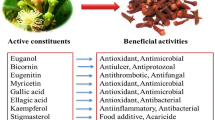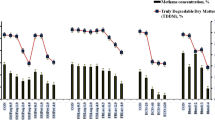Abstract
This study investigated the effects of vanillin on methanogenesis and rumen fermentation, and the responses of ruminal protein-degrading bacteria to vanillin (at concentrations of 0, 0.76 and 1.52 g/L), essential oils (clove oil, 1 g/L; origanum oil, 0.50 g/L, and peppermint oil, 1 g/L), and quillaja saponin (at concentration of 0 and 6 g/L) in vitro. Methane production, degradabilities of feed substrate, and ammonia concentration decreased linearly with increasing doses of vanillin. Concentration of total volatile fatty acids also decreased, whereas proportion of butyrate tended to increase linearly with increasing doses of vanillin. Protozoa population decreased, but abundances of Ruminococcus flavefaciens, Prevotella bryantii, Butyrivibrio fibrisolvens, Prevotella ruminicola, Clostridium aminophilum, and Ruminobacter amylophilus increased with increasing doses of vanillin. Origanum and clove oils resulted in lower ammonia concentrations compared to control and peppermint oil. All the tested essential oils decreased abundances of protozoa, Selenomonas ruminantium, R. amylophilus, P. ruminicola and P. bryantii, with the largest decrease resulted from origanum oil followed by clove oil and peppermint oil. The abundances of Megasphaera elsdenii, C. aminophilum, and Clostridium sticklandii were deceased by origanum oil while that of B. fibrisolvens was lowered by both origanum and clove oils. Saponin decreased ammonia concentration and protozoal population, but increased the abundances of S. ruminantium, R. amylophilus, P. ruminicola, and P. bryantii, though the magnitude was small (less than one log unit). The results suggest that reduction of ammonia production by vanillin and saponin may not be caused by direct inhibition of major known proteolytic bacteria, and essential oils can have different inhibitory effects on different proteolytic bacteria, resulting in varying reduction in ammonia production.
Similar content being viewed by others
References
Bekele AZ, Koike S, Kobayashi Y (2010) Genetic diversity and diet specificity of ruminal Prevotella revealed by16S rRNA gene-based analysis. FEMS Microbiol Lett 305:49–57
Beauchemin KA, McGinn SM (2006) Methane emissions from beef cattle: effects of fumaric acid, essential oil, and canola oil. J Anim Sci 84:1489–1496
Burt S (2004) Essential oils: their antibacterial properties and potential applications in foods—a review. Int J Food Microbiol 94:223–253
Calsamiglia S, Busquet M, Cardozo PW, Castillejos L, Ferret A (2007) Invited review: essential oils as modifiers of rumen microbial fermentation. J Dairy Sci 90:2580–2595
Cardozo PW, Calsamiglia S, Ferret A, Kamel C (2005) Screening for the effects at two pH levels on in vitro rumen microbial fermentation of a high-concentrate beef cattle diet. J Anim Sci 83:2572–2579
Castillejos L, Calsamiglia S, Ferret A (2006) Effect of essential oil active compounds on rumen microbial fermentation and nutrient flow in in vitro systems. J Dairy Sci 89:2649–2658
Chaney AL, Marbach EP (1962) Modified reagents for determination of urea and ammonia. Clin Chem 8:130–132
Chobpattana W, Jeon IJ, Smith JS, Loughin TM (2002) Mechanisms of interaction between vanillin and milk proteins in model systems. J Food Sci 67:973–977
Davidson PM, Naidu AS (2000) Phyto-phenols. In: Naidu AS (ed) Natural food antimicrobial systems. CRC, Boca Raton, pp 265–293
Dorman HJD, Deans SG (2000) Antimicrobial agents from plants: antibacterial activity of plant volatile oils. J Appl Microbiol 88:308–316
Evans JD, Martin SA (2000) Effects of thymol on ruminal microorganisms. Curr Microbiol 41:336–340
FAO (2006) Livestock’s long shadow. Environmental issues and options. Food and Agriculture Organization of the United Nations, Rome
Firkins JL, Yu Z, Morrison M (2007) Ruminal nitrogen metabolism: perspectives for integration of microbiology and nutrition for dairy. J Dairy Sci 90(Suppl 1):E1–16
Fitzgerald DJ, Stratford M, Gasson MJ, Ueckert J, Bos A, Narbad A (2004) Mode of antimicrobial action of vanillin against Escherichia coli, Lactobacillus plantarum and Listeria innocua. J Appl Microbiol 97:104–113
Flachowsky G, Lebzien P (2006) Possibilities for reduction of nitrogen (N) excretion from ruminants and the need for further research—a review. Landbauforschung Volkenrode 56:19–30
Hristov AN, Lee C, Cassidy T, Heyler K, Tekippe JA, Varga GA, Corl B, Brandt RC (2013) Effect of Origanum vulgare L. leaves on rumen fermentation, production, and milk fatty acid composition in lactating dairy cows. J Dairy Sci 96:1189–1202
Katsunuma Y, Nakamura Y, Toyoda A, Minato H (2000) Effect of Yucca shidigera extract and saponins on growth of bacteria isolated from animal intestinal tract. Anim Sci J 71:164–170
Koike S, Kobayashi Y (2001) Development and use of competitive PCR assays for the rumen cellulolytic bacteria: Fibrobacter succinogenes, Ruminococcus albus and Ruminococcus flavefaciens. FEMS Microbiol Lett 204:361–366
McIntosh FM, Williams P, Losa R, Wallace RJ, Beever DA, Newbold CJ (2003) Effects of essential oils on ruminal microorganisms and their protein metabolism. Appl Environ Microbiol 69:5011–5014
Menke KH, Steingass H (1988) Estimation of the energetic feed value from chemical analysis and in vitro gas production using rumen fluid. Anim Res Dev 28:7–55
Newbold CJ, McIntosh FM, Williams P, Losa R, Wallace RJ (2004) Effects of a specific blend of essential oil compounds on rumen fermentation. Anim Feed Sci Technol 114:105–112
Patra AK, Kamra DN, Agarwal N (2010) Effects of extracts of spices on rumen methanogenesis, enzyme activities and fermentation of feeds in vitro. J Sci Food Agric 90:511–520
Patra AK, Saxena J (2009a) Dietary phytochemicals as rumen modifiers: a review of the effects on microbial populations. Antonie Van Leeuwenhoek 96:363–375
Patra AK, Saxena J (2009b) The effect and mode of action of saponins on the microbial populations and fermentation in the rumen and ruminant production. Nutr Res Rev 22:204–219
Patra AK, Saxena J (2010) A new perspective on the use of plant secondary metabolites to inhibit methanogenesis in the rumen. Phytochemistry 71:1198–1222
Patra AK, Saxena J (2011) Exploitation of dietary tannins to improve rumen metabolism and ruminant nutrition. J. Sci Food Agric 91:24–37
Patra AK (2011) Effects of essential oils on rumen fermentation, microbial ecology and ruminant production. Asian J Anim Vet Adv 6:416–428
Patra AK, Stiverson J, Yu Z (2012) Effects of quillaja and yucca saponins on communities and select populations of rumen bacteria and archaea, and fermentation in vitro. J Appl Microbiol 113:1329–1340
Patra AK, Yu Z (2012) Effects of essential oils on methane production, fermentation, abundance and diversity of rumen microbial populations. Appl Environ Microbiol 78:4271–4280
Philips S, Laanbroek HJ, Verstraete W (2002) Origin, causes and effects of increased nitrite concentrations in aquatic environments. Rev Environ Sci Bio/Technol 1:115–141
Russell JB, Strobel HJ, Chen G (1988) Enrichment and isolation of a ruminal bacterium with a very high specific activity of ammonia production. Appl Environ Microbiol 54:872–877
SAS (2001) Statistical Analysis Systems Institute, version 8. SAS Institute, Cary
Stevenson DM, Weimer PJ (2007) Dominance of Prevotella and low abundance of classical ruminal bacterial species in the bovine rumen revealed by relative quantification real-time PCR. Appl Microbiol Biotechnol 75:165–174
Sylvester JT, Karnati SK, Yu Z, Morrison M, Firkins J (2004) Development of an assay to quantify rumen ciliate protozoal biomass in cows using real-time PCR. J Nutr 134:3378–3384
Tajima K, Aminov RI, Nagamine T, Matsui H, Nakamura M, Benno Y (2001) Diet-dependent shifts in the bacterial population of the rumen revealed with real-time PCR. Appl Environ Microbiol 67:2766–2774
Ultee A, Bennink MHJ, Moezelaar R (2002) The phenolic hydroxyl group of carvacrol is essential for action against the food-borne pathogen Bacillus cereus. Appl Environ Microbiol 68:1561–1568
Wallace RJ, Arthaud L, Newbold CJ (1994) Influence of Yucca schidigera extract on ruminal ammonia concentration and ruminal microorganisms. Appl Environ Microbiol 60:1762–1767
Wallace RJ, McPherson CA (1987) Factors affecting the rate of breakdown of bacterial protein in rumen fluid. Br J Nutr 58:313–323
Wallace RJ, Onodera R, Cotta MA (1997) Metabolism of nitrogen-containing compounds. In: Hobson PN, Stewart CS (eds) The rumen microbial ecosystem. Blackie Academic and Professional, Madras, pp 283–328
Wang Y, McAllister TA, Yanke LJ, Cheeke PR (2000) Effect of steroidal saponin from Yucca schidigera extract on ruminal microbes. J Appl Microbiol 88:887–896
Westhoek H, Rood T, van den Berg M, Janse J, Nijdam D, Reudink M, Stehfest E (2011) The protein puzzle. PBL Netherlands Environmental Assessment Agency, The Hague, p p218
Yang WZ, Ametaj BN, Benchaar C, Beauchemin KA (2010) Dose response to cinnamaldehyde supplementation in growing beef heifers: ruminal and intestinal digestion. J Anim Sci 88:680–688
Yu Z, Michel FC Jr, Hansen G, Wittum T, Morrison M (2005) Development and application of real-time PCR assays for quantification of genes encoding tetracycline resistance. Appl Environ Microbiol 71:6926–6933
Yu Z, Morrison M (2004) Improved extraction of PCR-quality community DNA from digesta and fecal samples. Biotechniques 36:808–812
Acknowledgments
This work was supported in part by an OARDC grant (2010-007). A.K. Patra’s tenure at The Ohio State University was supported by a BOYSCAST fellowship from the Department of Science and Technology, India.
Author information
Authors and Affiliations
Corresponding author
Rights and permissions
About this article
Cite this article
Patra, A.K., Yu, Z. Effects of vanillin, quillaja saponin, and essential oils on in vitro fermentation and protein-degrading microorganisms of the rumen. Appl Microbiol Biotechnol 98, 897–905 (2014). https://doi.org/10.1007/s00253-013-4930-x
Received:
Accepted:
Published:
Issue Date:
DOI: https://doi.org/10.1007/s00253-013-4930-x




